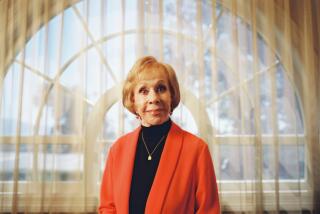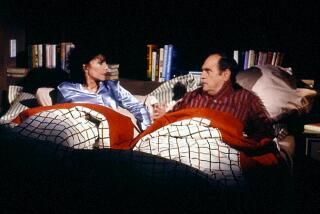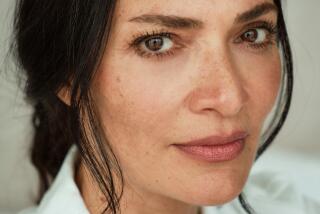Decades later, Betty Boop is still hard to resist
It’s not a new phenomenon, but it does appear to be on the rise: the exasperating vocal inflection known as the sexy-baby voice. Tina Fey focused her comic rage at it in an episode of “30 Rock.” Lake Bell takes a somewhat more compassionate aim in her new movie, “In a World…” But whatever the proper response to this affectation of today’s seemingly grown women, it would be wrong to consider them descendants of the distinctive-voiced cartoon siren Betty Boop.
A Jazz Age baby, Betty is a self-sufficient cookie, not a self-satisfied coquette.
The star of more than 100 spirited and gently risqué shorts in the 1930s, the animated flapper boop-oop-a-dooped into the upper registers as the flagship character of New York-based Fleischer Studios, a chief rival of Disney in the golden age of American animation. In 1932, two years after her first bit part in the Talkartoon series, producer-inventor Max Fleischer remade the series as Betty Boop Cartoons, with his brother Dave directing.
Betty is a sexual being, as animated characters go. She’s comfortable in her own hand-drawn skin, but she doesn’t necessarily rely on her looks to get by. Being a pragmatic child of the Depression, though, she knows how to work it when necessary. In 1934’s “Betty Boop’s Trial,” a square-jawed motorcycle cop chases her down to engage in some en-route flirting. She can’t be bothered — “Fresh!” she chides him — and speeds away in her roadster. One car crash later, she plays the all-male jury like a finely tuned fiddle.
That short is among the dozen in Volume 1 of “Betty Boop: The Essential Collection,” out Tuesday on DVD and Blu-ray from Olive Films. The first in a projected four-volume compilation that brings nonpublic-domain Boop material to home video for the first time, the black-and-white ‘toons are newly remastered in high definition and have a fine retro sheen.
Though a number of the selections were made after the Motion Picture Production Code went into effect, only one demonstrates the full impact of the morality guidelines on the free-spirited Betty: In 1937’s “Foxy Hunter,” she’s a supporting player again, while the wholesome adventure of her little boy and puppy claims center stage. No more signature wink and shimmy. No more strapless frock and exposed garter. She’s fully domesticated — although, intriguingly, apparently still single.
In the pre-Code days especially, the Fleischer brothers’ output stood apart from their competitors’ by targeting adults. And unlike the anthropomorphic critters at Disney, their characters were mainly of the humanoid variety. The roster included Superman, Koko the Clown and Popeye, who made his first screen appearance in a 1933 Betty Boop cartoon.
PHOTOS: Hollywood backlot moments
A seminal figure in animation, Max Fleischer invented Rotoscoping, a technique for frame-by-frame tracing of live-action footage. Betty Boop shorts exemplify his studio’s deft mix of playfulness and surrealism, stripped-down simplicity and loose-limbed exuberance. Rube Goldberg-isms pop up, and mechanical things sprout hands and legs when needed, as when a boat climbs down a waterfall. A number of handy creature-appliances prefigure the Stone Age innovations of “The Flintstones.”
Along with pop-culture references (Al Jolson, Fanny Brice, Maurice Chevalier), the scripts are lightly peppered with Yiddish. Betty herself might be Jewish, although the Fleischers left this matter ambiguous. In the early short “Minnie the Moocher,” not included in the Olive package, what at first appears to be a yarmulke on her father’s head might instead by a bald spot.
But she is definitely the child of European immigrants, like Max Fleischer, who was a toddler when his family moved from Galicia to New York. There’s no sense of entitlement about Betty, who’s at ease mixing it up with all types. She’s a city-bred woman of the people; when she runs for president, her opponent is, by contrast, a hat-wearing stick figure named Mr. Nobody.
And then there’s that voice. Betty Boop wasn’t the first to affect girlish tones, but in her pop-culture visibility she surpassed such real-life predecessors as Helen Kane, who served as a model. (Claiming that they’d unfairly caricatured her image, the singer-actress brought an unsuccessful lawsuit against Max Fleischer and Paramount, which released the Boop films.)
A number of performers have provided Betty’s voice, but Mae Questel, the originator, did so more often than any other. She also had the honors when Betty came out of retirement to cameo in “Who Framed Roger Rabbit.”
It’s a girlish voice, to be sure, somewhere between a chirp and a squawk. But there’s hard-earned spunk in that childish octave, a good-hearted New York toughness that puts her in a movie lineage defined by Clara Bow and Barbara Stanwyck. And her tenement trill creates a lovely counterpoint to the sophisticated jazz that the Fleischers often used, some by the likes of Cab Calloway and Louis Armstrong.
Unlike today’s “sexy babies,” Betty Boop never expects the world to coddle her. Beneath the spit curls and fluttering eyelashes, she’s always game and resilient and possessed of a self-knowing humor that makes her hard to resist.
More to Read
Only good movies
Get the Indie Focus newsletter, Mark Olsen's weekly guide to the world of cinema.
You may occasionally receive promotional content from the Los Angeles Times.










